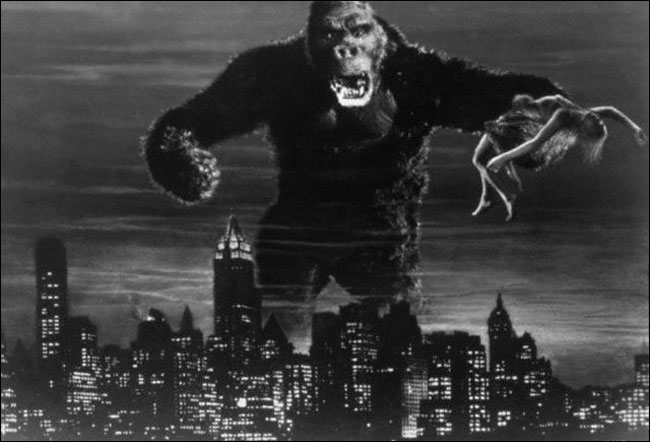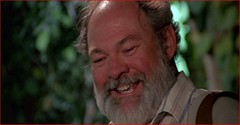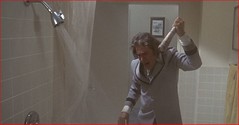
The soon-to-be-released King Kong has been No. 1 on my anticipated movie list since I heard Peter Jackson would be directing it. No one else I can think of has the fearless approach to filmmaking needed to turn 'King Kong' into a the powerful and meaningful movie it deserves to be. Forget the 1976 albatross of a remake, I knew Kiwi Pete would dive into this project beard-first, treating the story with the same weight as his Lord of the Rings movies. The other aspect I knew would work in the favor of a new 'Kong' was that, unlike many remakes, most audiences (especially younger ones) have not seen the original. Well, I have, and I'm here to tell you that it's more than just a giant ape which has inspired the biggest movie of the season.
Despite its startling special effects, the original 'King Kong' was made on a budget that was small even for 1933, about $600,000, and much of that was obviously devoted to the effects. As such, the first third of the film is almost maddeningly simple and ordinary, but the early scenes have a certain charm to them, because they lull you to sleep a little bit before 'Kong' turns on the afterburners for the rest of the movie. Though most of today's generation has not seen the movie, plenty know the story: director Carl Denham is off on a ship to find his next action picture, and all he needs is a dame crazy enough to be his leading lady, dame is offered to Kong, Kong likes dame, Kong taken to New York, escapes, finds dame and is killed from machine gun fire from bi-planes.
It's a simple enough story, but in my opinion what has made 'Kong' such a classic is what else happens on Skull Island. After Kong grabs his lady and heads back into the jungle, Denham and his crew follow and the audience finds much more than just a giant gorilla. The men ward off a stegosaurus, Kong has a brutal fight with a T-Rex, barely survives an encounter with a giant snake and even has to shoo away a pterodactyl who had eyes for his woman. It is in these scenes that the unflinching action and still-effective special effects come alive. When Kong fights the T-Rex, it is absolutely brutal, the action not the effects. The two beasts throw each other to the ground and the battle lasts a bit longer than you would think, with Kong triumphing after stretching the dinosaur's jaw until blood oozes out, leading to a wonderful shot of Kong playfully opening and closing his foe's jaws to see if it is really dead.
These effects were accomplished in 1933 and create a much different (and sometimes more effective) experience than many of today's effects. No matter how much money is spent on CGI effects, an audience always knows what they are looking at is fake. But the Kong effects can get away with more because the film is black and white and subsequently take on a much more physical quality, especially since Kong's fur constantly seems to be rippling (an unintended but highly successful byproduct of the animators' fingers constantly disturbing the rabbit fur that covered the miniature Kong).
The facial design of Kong is vital to the story, as the animators are able to present him with a playful, adolescent look moments after looking truly menacing. It's this youthful face that makes one scene truly memorable. Cut out of the original theatrical release at the request of censors, after Kong has scaled his mountain with his damsel, he delicately holds her and strips away a few layers of her dress, curiously examining each piece of this fabric he has never felt. As Kong peacefully strokes the curiosity in his hand, you genuinely believe that this 18-inch miniature ape model loves this woman, an emotion that is difficult to evoke even with today's CGI advances.
The best example of how CGI has 'ruined' some effects is one of my favorite action scenes of all time. In the classic King Solomon's Mines, there is a scene where our characters are trapped in a giant stampede, with literally hundreds and hundreds of all kinds of African creatures racing past them. There is a true sense of danger, because we know the animals are real. If this scene was ever attempted again, the animals would be born on computers and this sense of danger (which is sorely lacking in many of today's movies) would never exist. This same sense of realism is one reason why Kong has remained timeless.
The scenes of Kong escaping from the theater and scaling the Empire State Building are well-parodied and firmly entrenched in our subconscious, but many of the shots are truly striking. One in particular is when we first see Kong climbing the Empire State Building: instead of a closeup, director Merian C. Cooper wisely pulls far away from the action, showing us the surprisingly small silhouette of Kong inching his way up the building and in the background we see the terrifying shadows on the clouds of a fleet of attack planes heading for Kong. We know the ape's death is certain, but for a few seconds he gets to relive those minutes of bliss on his mountain when he sits undisturbed on the Empire State Building with his companion.
Initially it looks like Kong may be able to fend off the planes, but as their attacks become more precise, he looks at the blood pouring out of his chest and realizes he will not survive, until he finally tumbles off the side of the building. The genius of Kong's animation is that it is able to project these feelings of fear and love so that when he meets his doom, it becomes one of the very few monster movies where the audience is quietly saddened by the creature's demise.
It's easy to dismiss the original 'King Kong' as just another monster movie, but it is the scenes I mentioned above that I believe will be heightened emotionally and visually in Peter Jackson's version.
NOTES: One of the funniest parts of 'Kong' are some scenes that aren't included. After Kong is subdued with a smoke bomb and lays on the beach, Denham announces that they will put him on a raft and take him back to the ship. The next scene we see is 'King Kong: The Eighth Wonder of the World' on Broadway. Ummm, how exactly did you get this 20-foot tall monstrosity into and out of a ship and then into the heart of Manhattan? The filmmakers probably had no idea themselves, and it's almost comical how they 'skip' those scenes. 
Wednesday, November 30, 2005
Before 'Kong' There Was ... 'Kong'
Filed Under Classic reviews
Subscribe to:
Post Comments (Atom)











No comments:
Post a Comment